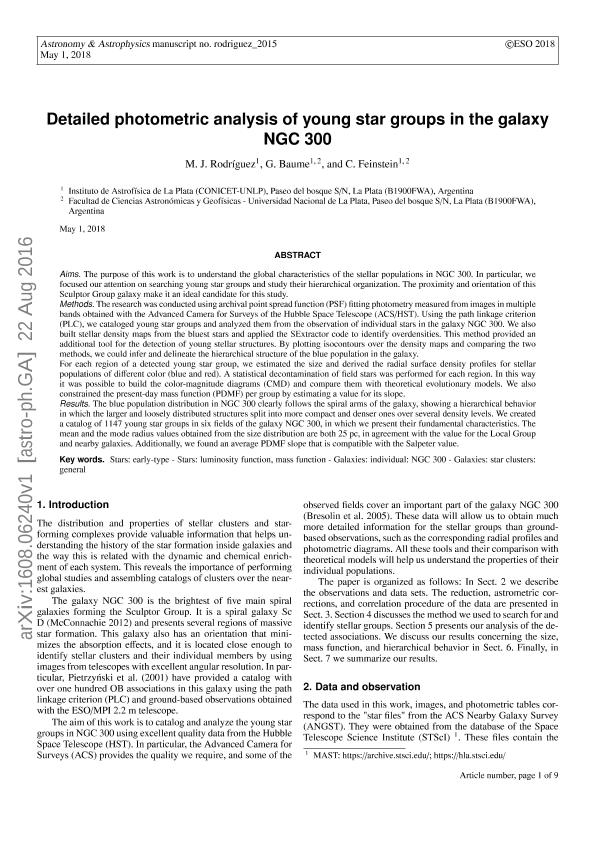Mostrar el registro sencillo del ítem
dc.contributor.author
Rodriguez, Maria Jimena

dc.contributor.author
Baume, Gustavo Luis

dc.contributor.author
Feinstein Baigorri, Carlos

dc.date.available
2020-10-22T17:53:24Z
dc.date.issued
2016-10
dc.identifier.citation
Rodriguez, Maria Jimena; Baume, Gustavo Luis; Feinstein Baigorri, Carlos; Detailed photometric analysis of young star groups in the galaxy NGC 300; EDP Sciences; Astronomy and Astrophysics; 594; 10-2016; 34-42
dc.identifier.issn
0004-6361
dc.identifier.uri
http://hdl.handle.net/11336/116349
dc.description.abstract
Aims: The purpose of this work is to understand the global characteristics of the stellar populations in NGC 300. In particular, we focused our attention on searching young star groups and study their hierarchical organization. The proximity and orientation of this Sculptor Group galaxy make it an ideal candidate for this study. Methods: The research was conducted using archival point spread function (PSF) fitting photometry measured from images in multiple bands obtained with the Advanced Camera for Surveys of the Hubble Space Telescope (ACS/HST). Using the path linkage criterion (PLC), we cataloged young star groups and analyzed them from the observation of individual stars in the galaxy NGC 300. We also built stellar density maps from the bluest stars and applied the SExtractor code to identify overdensities. This method provided an additional tool for the detection of young stellar structures. By plotting isocontours over the density maps and comparing the two methods, we could infer and delineate the hierarchical structure of the blue population in the galaxy. For each region of a detected young star group, we estimated the size and derived the radial surface density profiles for stellar populations of different color (blue and red). A statistical decontamination of field stars was performed for each region. In this way it was possible to build the color-magnitude diagrams (CMD) and compare them with theoretical evolutionary models. We also constrained the present-day mass function (PDMF) per group by estimating a value for its slope. Results: The blue population distribution in NGC 300 clearly follows the spiral arms of the galaxy, showing a hierarchical behavior in which the larger and loosely distributed structures split into more compact and denser ones over several density levels. We created a catalog of 1147 young star groups in six fields of the galaxy NGC 300, in which we present their fundamental characteristics. The mean and the mode radius values obtained from the size distribution are both 25 pc, in agreement with the value for the Local Group and nearby galaxies. Additionally, we found an average PDMF slope that is compatible with the Salpeter value.
dc.format
application/pdf
dc.language.iso
eng
dc.publisher
EDP Sciences

dc.rights
info:eu-repo/semantics/openAccess
dc.rights.uri
https://creativecommons.org/licenses/by-nc-sa/2.5/ar/
dc.subject
STAR CLUSTERS
dc.subject
GALAXY: NGC 300
dc.subject
STAR FORMATION
dc.subject
MASS FUNCTION
dc.subject.classification
Astronomía

dc.subject.classification
Ciencias Físicas

dc.subject.classification
CIENCIAS NATURALES Y EXACTAS

dc.title
Detailed photometric analysis of young star groups in the galaxy NGC 300
dc.type
info:eu-repo/semantics/article
dc.type
info:ar-repo/semantics/artículo
dc.type
info:eu-repo/semantics/publishedVersion
dc.date.updated
2020-09-25T16:49:45Z
dc.journal.volume
594
dc.journal.pagination
34-42
dc.journal.pais
Francia

dc.journal.ciudad
Paris
dc.description.fil
Fil: Rodriguez, Maria Jimena. Consejo Nacional de Investigaciones Científicas y Técnicas. Centro Científico Tecnológico Conicet - La Plata. Instituto de Astrofísica La Plata. Universidad Nacional de La Plata. Facultad de Ciencias Astronómicas y Geofísicas. Instituto de Astrofísica La Plata; Argentina
dc.description.fil
Fil: Baume, Gustavo Luis. Universidad Nacional de La Plata. Facultad de Ciencias Astronómicas y Geofísicas; Argentina. Consejo Nacional de Investigaciones Científicas y Técnicas. Centro Científico Tecnológico Conicet - La Plata. Instituto de Astrofísica La Plata. Universidad Nacional de La Plata. Facultad de Ciencias Astronómicas y Geofísicas. Instituto de Astrofísica La Plata; Argentina
dc.description.fil
Fil: Feinstein Baigorri, Carlos. Universidad Nacional de La Plata. Facultad de Ciencias Astronómicas y Geofísicas; Argentina. Consejo Nacional de Investigaciones Científicas y Técnicas. Centro Científico Tecnológico Conicet - La Plata. Instituto de Astrofísica La Plata. Universidad Nacional de La Plata. Facultad de Ciencias Astronómicas y Geofísicas. Instituto de Astrofísica La Plata; Argentina
dc.journal.title
Astronomy and Astrophysics

dc.relation.alternativeid
info:eu-repo/semantics/altIdentifier/url/http://www.aanda.org/articles/aa/abs/2016/10/aa27876-15/aa27876-15.html
dc.relation.alternativeid
info:eu-repo/semantics/altIdentifier/doi/http://dx.doi.org/10.1051/0004-6361/201527876
dc.relation.alternativeid
info:eu-repo/semantics/altIdentifier/arxiv/https://arxiv.org/abs/1608.06240
Archivos asociados
